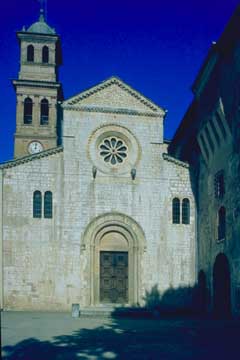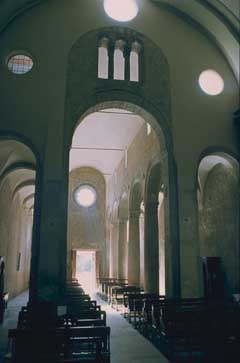| CHURCH OF S.PIETRO, 12th century,
with a frieze of the 5th century. The interior comprises a
barrel-vaulted nave and two cross-vaulted side-aisles. Although a
16th-century enlargement of the choir destroyed the original apsidal
complex, the church still constitutes one of the most handsome
examples of Romanesque in the area.
Its position by the main road has made it well visited by pilgrims,
and Franciscan literature records visits by St. Francis and his
companions. The vision that Brother Pacifico had of Lucifer's throne
commandeered by St. Francis, painted in fresco by Giotto in the
Basilica of Assisi, occurred during one of these visits, while the
friar was praying before the Crucifix. For this reason the church and
the
CRUCIFIX of Bovara form an important stage
of the
Franciscan Itinerary
The attached conventual buildings of the
ABBEY founded in 1158 by the Benedictines quickly rose to a great
splendor. The monks were responsible for important work in draining
the valley, and thus the resulting development of agriculture there.
200 meters from the abbey enclosure, toward the mountain, the
thousand-year-old olive tree of St. Emiliano
makes a notable presence.
The area has seen a number of archaeological finds that bear
witness to very ancient settlements.
The Bovara stela. Found in the
1950's, it barely received any notice at all and was reused as
building stone with the inscription on the inside of the wall.
Rediscovered in the early 1980's, it is awaiting exposition in the "Raccolta
d'Arte di S. Francesco".
It is a two line inscription in archaic Latin, and has not yet been
fully studied.
ROMAN MOSAIC. An important witness to the Roman era
settlements, it has been cited by a number of authors as having been
unearthed several times and several times buried again by silt
deposits. It was most recently unearthed in 1943-44; since then, it
has lain undistrubed under a layer of soil slightly downstream from
the very old Roman road that linked Trevi to the stone bridge over the
Clitunno; the Latin adjective for "stone" (lapideus) has become
the name of the village of Lapigge. |

